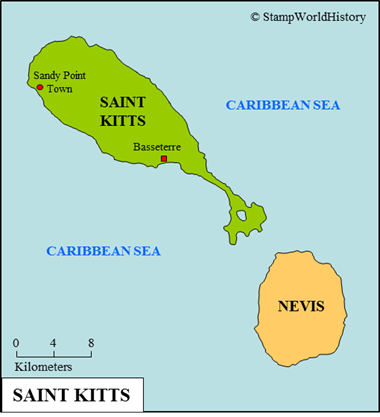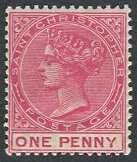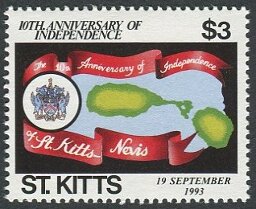
Saint Kitts
Leeward Islands
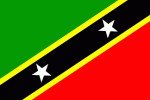
Saint Kitts
Saint Kitts & Nevis
Quick reference
General issues: Presidency Leeward Islands 1870-1882, Postal Area Saint Kitts & Nevis 1882-1890, Postal Area Saint Kitts & Nevis/Associated state 1980-1983, Postal area Saint Kitts & Nevis/Independent within the British Commonwealth 1883-Present
Country name on general issues: Saint Christopher, St Kitts
Currency: 1 Pound = 20 Shilling, 1 Shilling = 12 Pence 1870-1890, 1 Dollar = 100 Cent 1980-Present
Population: 28 200 in 1871, 35 200 in 2001
Political history Saint Kitts
Saint Kitts – the alternate name is Saint Christopher – is located in the Caribbean as one of the Lesser Antilles – for the exact location, please refer to the map of the Caribbean. Prior to colonization, the island was inhabited by the Amerindian Carib people that are found on many of the Lesser Antilles. The first European to sight the island was Christopher Columbus in 1493. The first permanent settlement was established by the British in 1623, followed by the French who also settled on Saint Kitts in 1625. In response to an attack, allegedly planned on the British and French settlements, the Carib population was massacred in 1626. In 1627, the British and the French formally divided Saint Kitts between themselves. In subsequent years, the island was a springboard for further colonization of the Lesser Antilles for both nations. The division would not provide stability – throughout the 17th century Saint Kitts was disputed and, at times, the entire island was occupied by either the British or the French. In 1713, the French ceded the entire island to the British. A last attempt to gain possession of the island was made by the French in the late 18th century.
Saint Kitts would, from the 17th until the 20th century, almost continuously be administered as part of the Leeward Islands colony – the federal colony that grouped together the British possessions in the Leeward Islands. In 1825, Anguilla – also part of the Leeward Islands – was made a dependency of Saint Kitts. From 1871, Saint Kitts was formally designated as a presidency of the Leeward Islands. Shortly after, in 1883, Saint Kitts, Nevis and Anguilla were grouped together as the presidency of Saint Kitts & Nevis, renamed Saint Kitts, Nevis & Anguilla in 1952. A grouping that would lead to much dispute as both Anguilla and Nevis resented being joined with Saint Kitts. The presidency of Saint Kitts, Nevis & Anguilla existed until the Leeward Islands colony was dissolved in 1956 and the presidency became a separate colony. As such, Saint Kitts, Nevis & Anguilla, between 1958 and 1962, joined the West Indies Federation – a short lived federation of most of the British possessions in the West Indies.
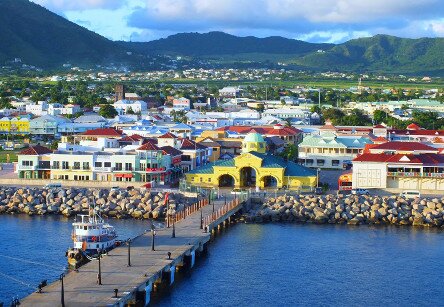
Basseterre is the capital of Saint Kitts
In 1967, Saint Kitts, Nevis & Anguilla gained associated statehood. Anguilla revolted, demanding to be separated from Saint Kitts and Nevis. Anguilla would, subsequently, be administered as a de facto separate colony until granted the de jure status of a separate British dependency in 1980. Consequently, Saint Kitts, Nevis & Anguilla was, in 1980, renamed Saint Kitts & Nevis and would, as such, gain independence within the British Commonwealth in 1983.
Economically, the British, from the 17th century, developed sugar cane plantations on Saint Kitts. To man the plantations, slaves were brought from Africa. Saint Kitts developed to become one of the wealthiest British colonies, until the sugar cane trade went into decline in the 19th century. Yet, sugar cane would remain the main economic activity until the late 20th century, when the focus was shifted to tourism, which is currently the most important sector of the economy. On the United Nations Human Development Index, Saint Kitts & Nevis rank as a High Development Country. The population is predominantly black.
Postal history Saint Kitts
Saint Christopher
The first stamps used in Saint Kitts were the general issues from Great Britain, which were used between 1858 and 1860. The first stamps for Saint Kitts were issued in 1870. This issue, and subsequent issues, are of the same design, showing the portrait of Queen Victoria. Aside from the definitives, in times of short supplies several provisionals were issued, and in 1890 Saint Kitts even resorted to the use of stamps of Antigua. Although grouped together with Nevis in 1882 to form Saint Kitts & Nevis, Saint Kitts continued to issue stamps until 1890, when the stamps of Saint Kitts were superseded by the issues of the Leeward Islands. The issues from this period are inscribed ‘Saint Christopher’ and were not used on the dependency of Anguilla as the first post office on Anguilla was not opened until 1904. Between 1890 and 1903 the stamps of the Leeward Islands were used exclusively. When, in 1903, the presidencies of the Leeward Islands again issued stamps, that were used concurrent with the issues of the Leeward Islands until 1956, Saint Kitts would come to use the issues of Saint Kitts & Nevis and, from 1952, the issues of Saint Kitts, Nevis & Anguilla.
Saint Kitts
In 1980, Anguilla was de jure separated from Saint Kitts and Nevis. In the newly formed associated state of Saint Kitts & Nevis, Nevis had a large amount of self government. This is reflected in the postal arrangements. Since 1980, Saint Kitts and Nevis have each issued their own stamps as postal areas of Saint Kitts & Nevis. An arrangement that was continued after independence was gained in 1983. The issues of Saint Kitts, since 1980, are a blend of issues with designs of national interest and designs aimed at the thematic collectors market. The issues from this period are inscribed ‘St. Kitts’.
For an overview of the political and postal developments in the form of a diagram, please refer to the country diagram of the British Leeward Islands.
Album pages
← Previous page: Puerto RicoNext page: Saint Kitts, Nevis & Anguilla →

